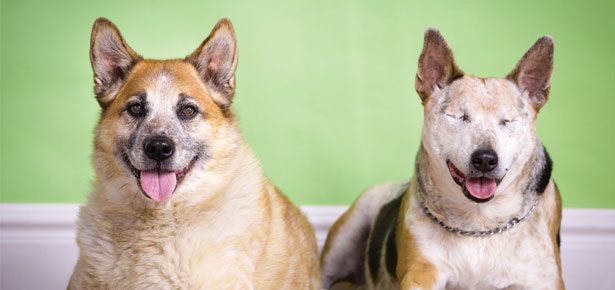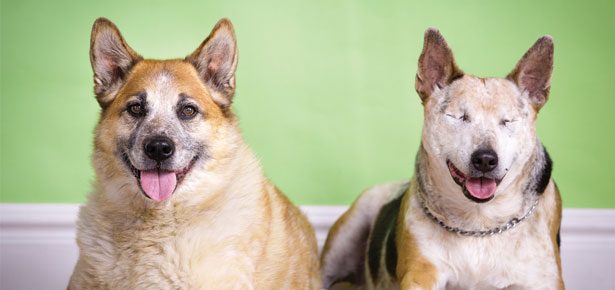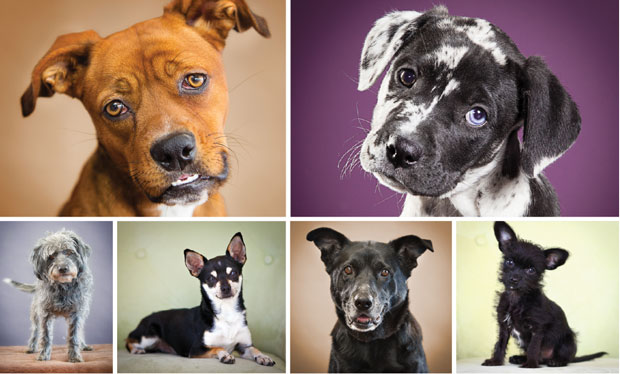

Using your Passion For Photography to Help Dogs in Need
Photographer Mark Stevens' tips for how to use your camera to get dogs adopted
Your passion for photography can help dogs in your local shelter get adopted faster! Why not put you photo skills to good use? Reach out to your local shelter or rescue group and ask if they need a volunteer to take photos of the adoptable dogs in their care.
We asked professional pet photographer Mark Stevens (markstevensphotography.com) for his tips on how to get the best photos of shelter dogs.
*All of the dogs shown here were photographed by Mark and have since been adopted. The dogs at the top of this article, Chico, a blind Cattle Dog and Max, his seeing eye dog, landed in rescue after their human passed away. Mark's photo got the duo international attention and a forever home!
- Focus your efforts on the dogs that are least likely to be adopted. Shelters rarely need pictures of the puppies. Put your efforts into the senior and disabled dogs or those facing euthanasia sooner.
- Before you start, learn as much as you can about dog behaviour. You can avoid many problems just by knowing when dogs are uncomfortable and how to help them have a more enjoyable experience. Your shelter likely has classes for handling their animals.
- Learn how to take a great photo of a jet black dog. (Hint: you’ve got to take manual control of your camera. Auto settings will get it wrong.)
- Do everything in your power to make the setting look attractive and homey. If you’re not allowed to remove the dog from the shelter, take something to dress up the background so it’s not just cages. In play areas and parks, do your best to avoid background distractions like fences, poles, and trashcans.
- Use the knowledge of shelter staff to help you capture the dogs’ personalities. You will hear things like “this dog looks so tough but she’s so sweet.” Think about ways you can show that.
- Limit distractions and work with one dog at a time. Having more than one dog around means social time not photo time. Look for an isolated area and only use the people you need so as not to further distract the dog.
- All dogs, especially anxious or aggressive ones, will benefit from exercise before their session. If there’s any way to get them vigorous play time or a run before their photos, do it. The pent up energy from the shelter makes it harder for them to stay focused during their photos..
- NEVER greet unknown dogs nose to nose. Never give them a hug. Be confident and calm. Your mistake could mean their life if you get bitten.
- If leashing is necessary, ask your helper to put one end of the leash on her wrist and gently hold the slack up and away from the dog with their other hand. You can Photoshop the leash out later. Ask your helper to use minimal pressure so that the dog’s collar sits relaxed and he doesn’t appear to be straining.
- Don’t feel sorry for them. Treat the dogs with dignity and respect and it will bolster their confidence and comfort.
- Don’t force. Anxious dogs may have to be distracted again and again with short walks, play or treats. Never physically force them into a place or position.
- Potential adopters want to see a happy or at least comfortable dog. Do your best to make the dog look happy and choose photos that most reflect a happy and relaxed disposition.
- If the dog responds with anxiety to the camera, consider backing off and zooming in. Being further away can mean less intense pressure for the dog and can help you get a better shot.
- Be critical: does the dog look scared or unsure? Is the dog looking and unhappy? If it’s not great, try again. Don’t settle on an okay photo. Your photo could literally mean the difference between life and death.
- Consider that most photos are first viewed as thumbnails. Zoom in on the dog and ask yourself if the photo is compelling at a small size.
- Follow through and get the shelter your photos in the format they need—and quickly—so they can get them online and find the dogs homes.
- And lastly, have fun! A positive, confident attitude is both reassuring and contagious.
Join the newsletter and never miss out on dog content again!
"*" indicates required fields
By clicking the arrow, you agree to our web Terms of Use and Privacy & Cookie Policy. Easy unsubscribe links are provided in every email.
